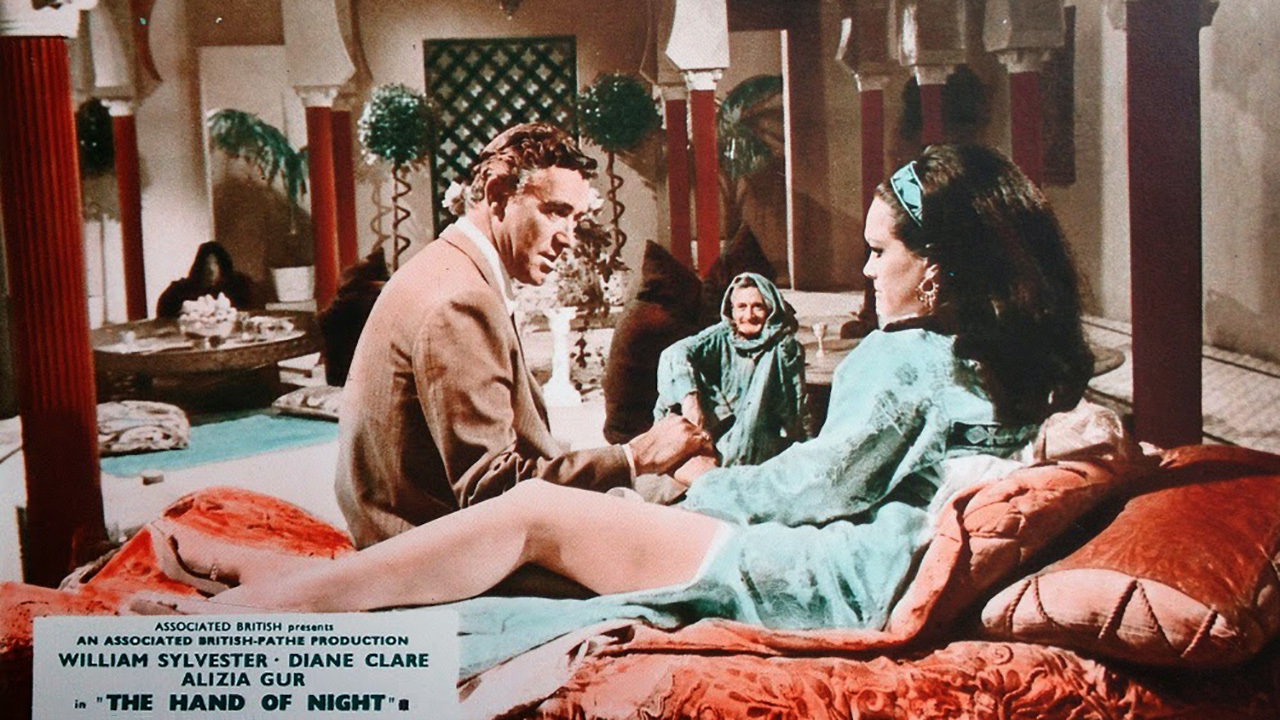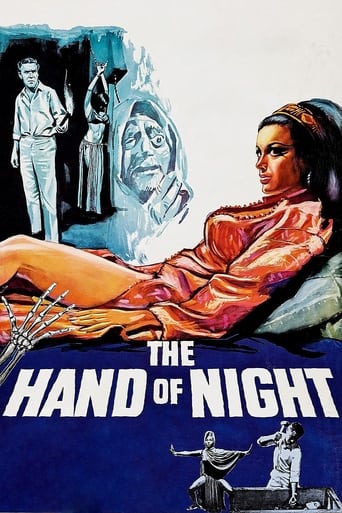

William Sylvester (Carver) blames himself for the death of his wife and children in a car accident and has given up with life. He goes to Morocco to hopefully recuperate but he seems to have gained access to the ethereal world that is ruled by Aliza Gurr (Marisa), a dead princess who has put a curse on men she encounters as she wanders around at night-time.It's not a particularly good film but it does hold an interest because of the different feel to it - it is set in Morocco with spacious vistas to take in and the storyline involves vampires in the desert.The cast are not particularly wonderful. Apart from Sylvester and Gurr, only Terence De Marney (Omar), who plays a vampire henchman, does not attempt an accent. However, this very obviously looking Brit does not convince as an arab. As for the others in the cast, Diane Clare (Chantal) clearly can't act and is the worst offender when it comes to failing with an accent - it's really quite annoying.Still, the film scores for being different - those poor gypsy belly-dancers!
... View MoreWilliam Sylvester plays an architect Paul Carver,whose wife and children died in a tragic car accident.He goes on a business trip to Morocco and meets a stunning dark-haired female vampire named Marisa.The opening scene of "The Hand of Night" is wonderfully atmospheric and weird with the use of skulls and bloodied mechanical bats.The film was shot in Morocco,so the location sets are magnificent.Alizia Gur is particularly memorable as a beautiful vampire,who feeds on hope.Paul is also an interesting character.He is grief driven,defeated and obsessed with death.The score by Joan Shakespeare is quite eerie,but the direction is pretty weak and some scenes are very dull.6 Morrocan vampires out of 10.
... View More"The Hand of Night" (British title) was actually scripted as a vampire film 'without blood,' an effective mood piece, featuring American veteran of British horrors such as "Gorgo," "Devil Doll," and "Devils of Darkness," William Sylvester starring as architect Paul Carver, tortured for two months by the loss of his wife and family in a car crash, whose seeming death wish finds him bedazzled by the denizens of the dark in present day Morocco (in other words, what if the Mummy was a vampire?). These fangless vampires are unaffected by Christian symbols like the cross, fearing only the light, feeding not upon blood but upon life itself, not unlike those in "Captain Kronos: Vampire Hunter" (they still cast no reflection). Revived by the recent excavation of her long buried tomb, 14th century princess Marisa was the most cherished prize in her husband's harem, buried alive for her faithlessness, but not before pronouncing a fateful curse, explained by archaeologist Leclerc (William Dexter): "here lies one who does not sleep, but walks the night of death to make all mankind her slave." A curiously passionless performance from Alizia Gur, beautiful former Miss Israel in 1960, one of the two fighting gypsy girls in 1963's "From Russia with Love" (the girl in blue was Martine Beswicke). Miss Gur's career petered out in the early 70s while blonde heroine Diane Clare apparently threw in the towel even earlier. Miss Clare had her share of genre titles, ranging from "The Naked Edge" (Peter Cushing), "The Haunting," "Witchcraft" (Lon Chaney), "The Plague of the Zombies," and "The Vulture" (this was her final feature). Diane has the lines that inspired the original title: "to reach out the hand from dying day, is to clutch the hand of night" (as unsuccessful in Britain under that title as in the US release under "Beast of Morocco"). Like Diane Clare, Edward Underdown was a guest star on THE AVENGERS, and played in the 1965 James Bond feature "Thunderball." Veteran British player Terence de Marney, who had appeared with both Lugosi (1935's "The Mystery of the Marie Celeste") and Karloff (1965's "Die, Monster, Die!"), sparks the proceedings as vampire servant Omar, whose demise at sunrise is by far the standout sequence, as seen in the picture's ads. This marked the climax of William Sylvester's starring career, moving on to Kubrick's "2001: A Space Odyssey," 1973's TV chiller "Don't Be Afraid of the Dark," and his final feature role as a TV interviewer in 1980's "First Family" ("nearly 30 million Americans actually voted for the two corpses!"). Becoming ever more obscure over the decades, "Beast of Morocco" made three appearances on Pittsburgh's Chiller Theater, Apr 11 1970 (preceded by 1959's "The Purple Gang"), Apr 3 1971 (followed by 1966's "Curse of the Swamp Creature"), and May 20 1972 (followed by 1958's Mexican title "The Black Pit of Dr. M").
... View MoreI could only get hold of this film on a very dodgy video, and I'd have liked to have seen it in better quality. As other reviewers in old film magazines say, the dream sequence is intriguing and a little spacey. However, would I call it horror? Probably not, it's more of a psychological exploration of a man and his grief, and how that goes into a hyper-real state. The Moroccan landscape was good though - I guess that gave it the element of - is this real? or just his confused mind? Willaim Sylvester is a bit of a disaster as the lead. He was reliable stock actor in B movies of the time, and he doesn't have the power to lift his ability - which is really required - to play this character.
... View More